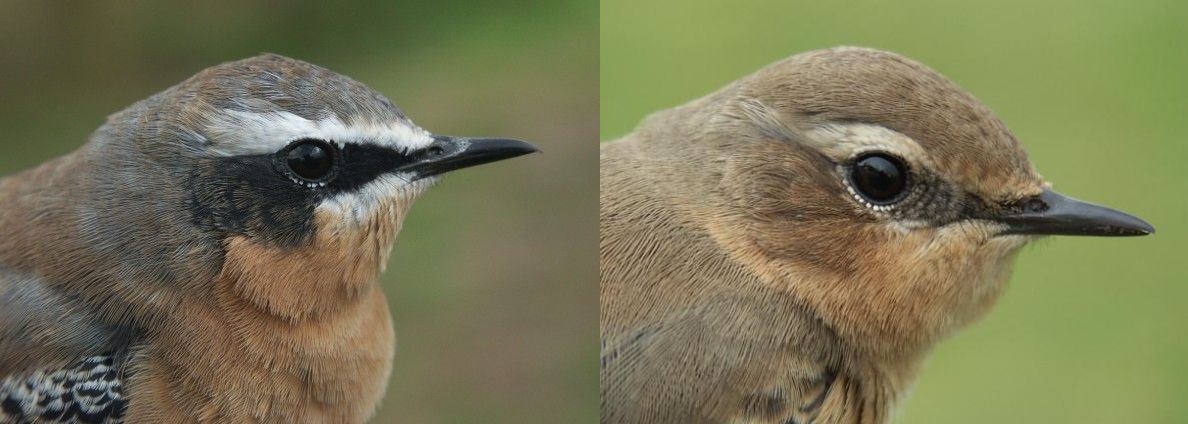Another autumn season (17 September 2006)
I wish I could catch more adult Sylvia warblers, because they often seem to show interesting examples of moult. A Whitethroat Sylvia communis ringed on 3 August 2006 was adjudged to be a second-year (Euring age 5) bird, with very worn plumage, dingy-brown outermost tail feathers and a dull eye. It was probably a female, with a brownish head rather than the greyish colour of a male:
.jpg)
It had only recently started its wing moult, presumably having had a second breeding attempt, and the moult was not extensive, with only its tertials and one primary feather actively growing: moult scores of 343 | 000000 | 5520000000. Whitethroats normally moult very quickly, completing their primary moult in about 40 days (BTO Guide 19, 'Moult in Birds', H B Ginn & D S Melville, BTO, 1983), and normally have several feathers actively growing at the same time. I suspect that this bird was likely to suspend its moult and migrate south before resuming and completing the full moult: I have depicted previously another bird like this.
Note that the outermost (first) secondary feather had broken off, at about the same length as the growing third primary:
.jpg)
The normal stage of Whitethroat moult expected less than three weeks later was shown by this bird photographed on 22 August. This bird also shows another of the oddities of Whitethroat moult, irregular growth of the secondaries, with the innermost secondary (s6) often grown with the tertials:
.jpg)
An adult male Garden Warbler Sylvia borin ringed on 16 July 2006 showed a really strange moult pattern. The first unusual feature was that it was moulting at all, since they normally migrate to Africa then moult there, but one undergoing a complete wing moult in Britain was depicted here previously. This year's bird was moulting all three tertial feathers and all of its tail, which seem to be reasonable tracts of feathers for a bird undergoing a partial moult, but it was also growing all of its greater (secondary) coverts: most odd!
.jpg)
A female Blackcap Sylvia atricapilla ringed on 16 September 2006 had almost finished her moult, with just the innermost three secondaries still growing, and within a day or two of being complete:
.jpg)
Her rectrices were somewhat more rounded than those of first-year birds:
.jpg)
An interesting Reed Bunting Emberiza schoeniclus was caught on 24 July 2006, an adult female:
.jpg)
Some ringers would not believe that this bird is a female, with an almost all-black head and a complete white collar extending around the nape, but she had an active brood patch and a fairly short wing length of 76.0mm. Interestingly, this bird had first been ringed as a juvenile in July 2005 so she was only one year old. There has been some suggestion that it is only female Reed Buntings approaching old age who develop blackish head plumage. This feature has been commented upon and illustrated on this website previously.
Birds that are completely in juvenile plumage tend to look fluffy, with rather scruffy, loose plumage. They leave the nest with fewer feathers than they grow in adult life, and their feathers are less dense and weaker. This is illustrated by a Goldcrest Regulus regulus ringed on 25 July 2006. Before their post-juvenile moult they cannot be sexed, having no colour on the head:
.jpg)
Another example was a Jay Garrulus glandarius ringed on 29 July 2006, just starting to moult out of its juvenile plumage:
.jpg)
A Song Thrush Turdus philomelos ringed on 18 July 2006, also completely in juvenile plumage, had its greater coverts showing the characteristic 'rose-thorn' pattern on every lesser, median and greater covert feather. Note the variation in pattern of the markings across the greater coverts: some of those coverts will be retained after its post-juvenile moult.
.jpg)
.jpg)
I have commented previously on finches eccentrically moulting one or more primary feathers in their first autumn of life. A Goldfinch Carduelis carduelis ringed on 15 August was moulting four primaries (p3-6), without moulting the corresponding primary coverts. This bird is similar to one illustrated on these pages before (ringed on 19 August 2004).
.jpg)
It still has its juvenile median coverts, and a very obviously juvenile head, only just starting to grow a few of the reddish head feathers:
.jpg)
It is interesting that, based on scant evidence - from only a few birds handled whilst actively moulting - it seems that the first-year Goldfinches that are going to moult their primaries do so very early, certainly before significant body and head moult, whereas the first-year Greenfinches that moult some primaries do so after completion of the normal post-juvenile moult. Some actively moulting Greenfinches were depicted here.
There is nothing unusual about which to comment on this Kingfisher Alcedo atthis, but they are always nice birds in the hand. Kingfishers often have a habit of twisting and turning their head:
.jpg)
.jpg)
On 29 August 2006 I was lucky to catch a Wheatear Oenanthe oenanthe in a normal mist-net. It turned out to be an adult male of the leucorhoa race, breeding in Greenland and Iceland. Many individuals, including this one, are separable from the nominate race on size, especially wing length.
.jpg)
This bird made a nice comparison with an adult female Wheatear caught at Walney island on 29 September 2004. In both pairs of images below, the adult male is on the left and the adult female on the right:

.jpg)
The Wheatear's close relative, Stonechat Saxicola torquata, had been a surprise capture at Woolston on 26 August. This bird was a very worn adult female that had just finished breeding (but where?) and was just starting wing moult:
.jpg)
David Norman.